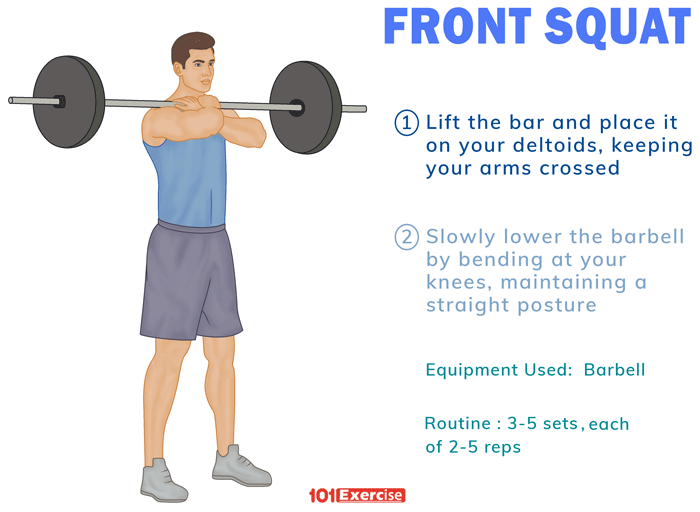Front Squat
- Alternative Names: Barbell front squat
- Type: Strength
- Experience Level: Expert
- Equipment: Barbell
- Muscles Targeted: Glutes, quads, calves, hamstrings, abs, upper back
- Mechanics: Compound
- Average Number of Sets: 3-5 with 2-5 reps each
- Variations: Dumbbell, Smith machine, Crossfit, kettlebell, with straps, with cable, and sandbag
- Alternative: Hack squat, barbell hack squat, barbell full squat
The front squat, usually performed with a barbell, is a leg- and hip-strengthening exercise that mainly works your quads, hamstrings, and glutes. It is an effective lifting exercise, which along with the back squat, can be included in your leg workout routine.
Although not as popular as the back squat, it is suitable for experienced gym trainees and can be performed by athletes, including sprinters, martial artists, wrestlers, swimmers, and rugby players.
Benefits
- Practicing front squats with proper body posture and bar positioning helps you in improving your Olympic lifting technique involving squatting variations like push presses or clean and jerks.
- Consistently training front squats improves your flexibility.
Front Squat vs. Back Squat
According to a 2009 study, front squat exerts slightly less compressive forces on your spine and knees as compared to the back squat. Therefore, it is suitable for those who are prone to knee and back problems.
If you know how to front squat properly, you will not have any trouble doing the back squat. However, the reverse might not be true. Lifters doing the back squat without the proper technique get out of position and end up hurting their lower back. Doing the front squat helps keep the torso more erect thereby helping you to learn the back-squat technique.
Front Squat Form: How to do It Properly
For safety purposes, set the barbell on a squat rack that matches your height. You can hold the barbell using either the clean grip in which you touch the bar with the fingers or the crossed-arm grip to keep the bar in position. If you have doubts regarding the safety of this exercise, use less weight.
Barbell Front Squat Tips
- Keep your elbows high with the upper arms above parallel to the ground throughout the exercise to prevent the weight from tipping forward and pushing you off-balance.
- While lifting the barbell, drive through your feet so that there are three points of contact, including your heel, big toe, and little toe.
- If you find it difficult to perform the exercise due to limited flexibility of your wrists and forearms, do some warm-up exercises by interlocking your fingers and then rotating the wrists for about 2 minutes.
Variations
- Dumbbell Front Squat: A front-squat variety suitable for those who have back issues or those who want to use less weight.
- Smith Machine Front Squat: Makes squatting easier and allows you to add higher weights.
- Kettlebell Front Squat: Similar to the dumbbell front squat but performed by holding two kettlebells by their horns.
- Front Squat with Straps: Suitable for those who find squatting with a clean grip challenging to perform.
- Cable Front Squat: Another easy version of the front squat performed using a low-pulley cable machine.
- Sandbag Front Squat: Requires greater core strength than the other front squat variations.
Alternative Exercises
- Hack Squat
- Barbell Hack Squat
- Barbell Full Squat

